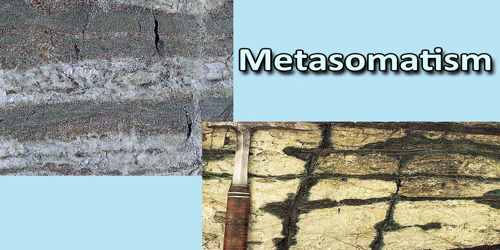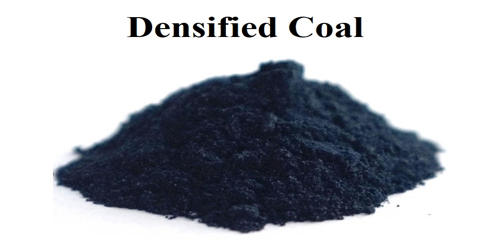Metasomatism
Definition
Metasomatism is the process by which the chemical composition of a rock is changed through the introduction or extraction of chemicals dissolved in fluids that migrate through the rock’s pores. Metasomatism often results in the formation of new minerals, especially metal ore deposits. Synonyms to the word metasomatism are metasomatose and metasomatic process. The word metasomatose can also be used as a name for specific varieties of metasomatism.
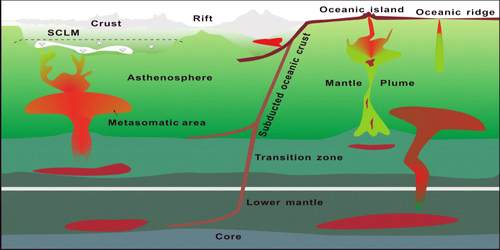
Metasomatic rocks, in general, have a granofelsic or granoblastic structure. They may be coarse- or fine-grained and may sometimes exhibit banding which may be rhythmic. They may demonstrably overprint earlier structures.
Metasomatism can occur via the action of hydrothermal fluids from an igneous or metamorphic source. From the group of processes including the infilling of cavities or cracks, magma crystallisation, and magma-rock interactions, by the preservation of rocks in the solid state during replacement, which is the volume of solution filling pores is negligible in comparison with the total rock volume.
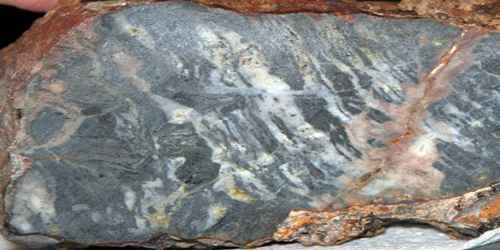
In the metamorphic environment, metasomatism is created by mass transfer from a volume of metamorphic rock at higher stress and temperature into a zone with lower stress and temperature, with metamorphic hydrothermal solutions acting as a solvent. This can be envisaged as the metamorphic rocks within the deep crust losing fluids and dissolved mineral components as hydrous minerals break down, with this fluid percolating up into the shallow levels of the crust to chemically change and alter these rocks.
Formations of Metasomatism
From magmatism and metamorphism by the formation of a regular set of zones. These zones form a characteristic pattern (metasomatic column) across the metasomatic body. The zonal pattern represents chemical equilibration between two rocks or between a rock and a filtrating fluid (solution).
Further, because metasomatism is a mass transfer process, it is not restricted to the rocks which are changed by addition of chemical elements and minerals or hydrous compounds. In all cases, to produce a metasomatic rock some other rock is also metasomatised, if only by dehydration reactions with minimal chemical change. The source region is often largely chemically unaffected compared to the highly hydrated, altered shear zones, but both must have undergone complementary metasomatism.
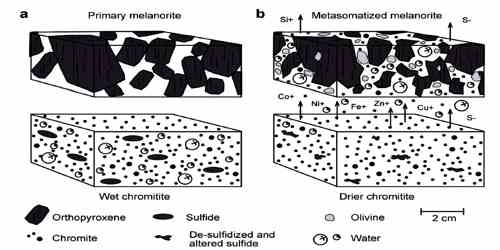
The classification of metasomatic rocks is a much more difficult problem than that of magmatic rocks. Knowledge of the mineral and chemical composition as well as the structural features is insufficient for determining the type of metasomatic process, because the composition of a metasomatic rock depends not only on T, P, and replaced rock composition, but also on the type and stage of the metasomatic process and the composition of the fluid or solution.
Modal metasomatism may result in formation of amphibole and phlogopite, and the presence of these minerals in peridotite xenoliths has been considered strong evidence of metasomatic processes in the mantle. Formation of minerals less common in peridotite, such as dolomite, calcite, ilmenite, rutile, and armalcolite, is also attributed to melt or fluid metasomatism.

Types of Metasomatites
There are two main types of metasomatism, namely, diffusional and infiltrational as determined by the prevailing nature of the mass transport. They are defined as follows:
- Diffusional Metasomatism – It is a type of metasomatism that takes place by the diffusion of a solute through a stagnant solution (fluid). The driving force of diffusion is the chemical potential (or chemical activity) gradients in the rock-pore solution.
- Infiltrational Metasomatism – It is a type of metasomatism that takes place by the transfer of material in solution, infiltrating through the host rocks. The driving force is the pressure and concentration gradients between the infiltrating and rock-pore solutions.
In such cases, characterising alteration often requires microscope investigation of the mineral assemblage of the rocks to characterise the minerals, any additional mineral growth, changes in protolith minerals, and so on.
In some cases, geochemical evidence can be found of metasomatic alteration processes. This is usually in the form of mobile, soluble elements such as barium, strontium, rubidium, calcium and some rare earth elements. However, to characterise the alteration properly, it is necessary to compare altered with unaltered samples.
Reference:
